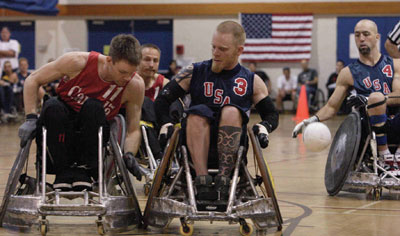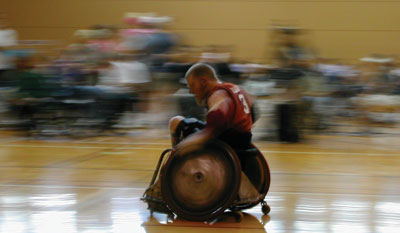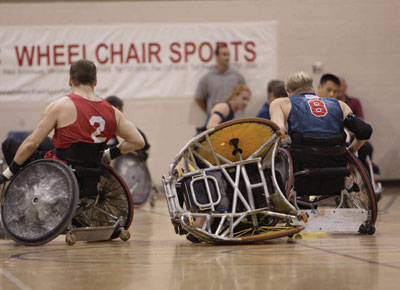IRON MEN
Directors Henry Alex Rubin and Dana Adam Shapiro capture the violent heart of quad rugby in Murderball.
BY JASON GUERRASIO
 |
| The USA and Canada battle it out in the 2002 World Championship Quadriplegic Rugby Tournament in Henry Alex Rubin and Dana Shapiro’s Murderball. |
Standing in a small gymnasium in Sweden, Henry Alex Rubin and Dana Adam Shapiro can’t believe what they’re seeing: quadriplegics ramming into each other with armored wheelchairs. The setting is the 2002 World Championship Quadriplegic Rugby Tournament, and up next are the finals between rivals, Team USA (undefeated and ranked No. 1 in the world) and Team Canada (coached by former U.S. great Joe Soares, who was cut from the U.S. squad and seeks revenge). The crowd is prepared for an epic battle, and Rubin and Shapiro are ready to capture it on film.
This would later be the opening to their documentary Murderball, an eye-opening look at the men who play quad rugby. With pulse-pounding action, heavy metal music and a dramatic conclusion, the filmmakers create a documentary that portrays the handicapped differently than any film ever has.
That’s what attracted THINKFilm to make the unprecedented move of financing the doc. Having never backed a documentary film during production, the distribution company took the leap after seeing a trailer Rubin and Shapiro made from the Sweden trip. (MTV Films has since come on board to co-present the release with THINKFilm.)
Though the film’s draw is its testosterone-filled battles between USA and Canada leading up to the 2004 Paralympics, its true triumph is the exploration of its subjects’ lives off the court. There’s Soares, whose obsession to beat the U.S. drives him further away from his son; Mark Zupan, one of Team USA’s top players, who comes face-to-face with the person who put him in the wheelchair, his best friend; and Keith Cavill, who, paralyzed after motocross racing, feels his life is over but then plays quad rugby.
Shattering the stereotypes pegged to quadriplegics — yes, they can have sex; they can even drive — Murderball (winner of the Documentary Audience Award and Special Jury Prize for Editing at this year’s Sundance) explores its subjects using humor and brutal honesty while never pitying them. And with their creative shooting style and fast-paced editing, Rubin and Shapiro continue the new breed of documentaries that are more feature narrative than their fathers’ talking-heads docs. The film opened July 8.
 |
| Murderball. |
FILMMAKER: Dana, you were the first to learn about murderball, right?
DANA ADAM SHAPIRO: Yeah. I was a senior editor at Spin magazine at the time and I came across this article online in February 2002 about quadriplegic rugby. [Producer] Jeff Mandel and I were looking to make a documentary and this subject was it. Quite simply, it was a story best told visually as opposed to writing a book about it.
FILMMAKER: How did Rubin get involved?
SHAPIRO: Jeff and I had never made a film before. We were basically going into this a little bit blind and relying on journalism, non-fiction storytelling. Henry, who I knew, made a documentary called Who Is Henry Jaglom? and had shot second unit for films like Cop Land and Girl, Interrupted, so we needed his experience.
HENRY ALEX RUBIN: Dana asked me if quadriplegic rugby would make a good movie. And it sounded completely impossible. It sounded like a contradiction actually. I assumed quadriplegics couldn’t move anything, so how could they play rugby? It sounded almost like a bad joke. We decided to go out there [Sweden] and see if we could find a story.
FILMMAKER: Dana, you devised a clever way to pay for the trip’s expenses: writing a story for Maxim.
SHAPIRO: Yeah. Jeff raised enough money for one person to go, so I had this idea of writing an article about the tournament and have them cover the expenses. But also the players were much more open because I was there from Maxim. Even when I was on the phone with them I was like, Yeah, we’re coming to do this article for Maxim and we’re also going to start shooting for a documentary, they were much more excited about the Maxim idea. When the article came out it really showed the tone that we were planning on taking with this film, which was very different from every other story about the handicapped. They were talking about sex, they were talking about sports, they were talking about violence. It was a way to show investors this material could be treated commercially.
FILMMAKER: How early on did it occur to you guys that you could take an anti-PC approach to the guys and the film?
|
RUBIN: We tried to reflect their attitudes. When we met them they were not at all what I expected to meet.
FILMMAKER: What did you expect?
RUBIN: Just sort of delicate people with afghan blankets on their legs who don’t go out much. And these guys, they can drink us under the table, and they have hotter girlfriends than us, and they talk trash. They call each other gimps, they throw each other over. So we tried hard with the shots, the composition, the music, the energy, and the whole aesthetic style to reflect their “no bullshit, no pity” attitude.
FILMMAKER: And it must have helped that they were so open with you guys?
RUBIN: They couldn’t wait to teach us things. We had sort of the legitimacy of the camera in front of our faces. If you don’t have a camera it’s a little more awkward to ask a guy in a wheelchair if he can have sex.
FILMMAKER: Speaking of sex, when you brought up that subject did you know they were able to do it?
RUBIN: We had sidebar conversations with the nurses, so we had a little bit of info.
SHAPIRO: It was one of those stereotypes that got shattered right off the bat. Not only can they move but they can play a sport; not only can they play a sport but it’s a full-contact sport. We really wanted to make a movie about quads from their perspective. I think a lot of docs are shot and told in a fly-on-the-wall perspective. We wanted to shoot the movie from their perspective, which is why a lot of it is shot literally from wheelchairs. We wanted to make a movie about what it’s like to be them, not what it’s like to be around them.
FILMMAKER: How did the idea come up to show someone just beginning to cope with a spinal-cord injury?
 |
| Murderball. |
SHAPIRO: We were unintentionally doing exactly what we hated about documentaries, which was putting this sunny face on it. We’re showing all the triumph but none of the loss, none of the darkness. We would look at the footage and be like, We’re shooting a movie about what it’s like to break your neck and we’re missing the most important point of that story: the transition from able-body to quadriplegic. All of them talked about it in such a deep way, how they tried to kill themselves, how they took pills, how they turned to drugs or drinking and how a lot of guys just don’t make it over those two years because they have one foot in still being an able-body.
RUBIN: So we wanted to find an element where we could see something happening in the now and make it more cinéma vérité, less talking heads. So Jeff ended up finding this guy Keith. He just seemed like the perfect eye through which to see the experience of having broken your neck. He sucks you in.
SHAPIRO: And you see it when he goes home and says, This sucks, I’m in a wheelchair. It’s the darkest moment of the movie, and when he meets Zupan and finds rugby it’s the brightest moment in the movie. This guy was saved by this sport, and we captured it live.
FILMMAKER: How did that come about, Keith seeing Zupan talk? Was it Keith’s interest or did you guys plant the seed?
SHAPIRO: They knew that we were doing a movie about quadriplegic rugby, and then Zupan happened to be selected to come to New York City to do the media conference for the Paralympics, and the rehab center asked him to come and talk. Keith was sort of the Everyquad, he was Zupan 10 years ago, and to have them actually meet each other was amazing.
RUBIN: It demonstrated the thing that we could never really show in our movie, which is the sport itself is totally rehabilitating to the spirit. Just the very act of Keith getting in Zupan’s chair changed his entire attitude about what was on the horizon for him. And now he’s training to play quad rugby.
FILMMAKER: What were some of the challenges that arose while filming?
RUBIN: A lot of times we’d see things but wouldn’t get them on film. What you manage to get on film is such a challenge — you’re just getting the tip of the iceberg of reality.
SHAPIRO: And we didn’t live in the same state as any of these people, so it wasn’t like we could just zip over there. We were really like snipers. We didn’t have a wasted shoot — there’s a piece of footage [in the film] from every single shoot we went on.
|
FILMMAKER: For two years you had been doing everything out of your own pockets, but you started looking for money to get to the Paralympics.
RUBIN: That was the scariest thing. That was the last shoot. It was our biggest shoot. It was the third act. For two years we’re wondering, Who the fuck’s going to win in Athens? So we needed money. We were on the verge of maybe pulling out our credit cards, but thank goodness THINKFilm came in.
FILMMAKER: How did you grab their interest?
RUBIN: We shot 20 hours in Sweden and we chopped up the whole thing into two and a half minutes and made this DVD. We had it floating out there for a year while shooting the doc, and THINKFilm came and said, We love this and we’re going to finance it. With that money we were able to go to Athens with extra crew, we were able to rent a little more equipment and we were able to cover it in a way in which it was epic. But we didn’t even know if we could even get on the floor to shoot.
SHAPIRO: Clearance for this film was insane. We shot in 10 states, we shot in Canada, Sweden and Greece. Now when we had to go to the Paralympics, which is the second largest sporting event in the world next to the Olympics, people own that footage, and we were able to use the footage only because Mandel, who’s a lawyer, was a master at figuring out a way to allow us to use it. We were lucky, though. Through a combination of extensive research and the good offices of Miriam Wilkins, as well as many other outstanding professionals in Paralympic and Olympic family we were able to get everything together.
FILMMAKER: I’ve read you anticipated you wouldn’t get clearance at Athens and looked for another way to end the film.
RUBIN: We don’t talk about that much, but it’s true. There were two things that could really have gone wrong. Canada and the U.S. could have never met or we could have gone there and just not have gotten the access. So we were preparing this alternate third act, the world championship in Vancouver.
SHAPIRO: We filmed it and the United States team won. It was the Rocky structure that we had talked about from the beginning. But it was incredibly unspectacular because it took place in a gym in Canada as opposed to Greece, but we were okay with it. It was a huge comfort, because making a documentary, you never know how it’s going to end.
RUBIN: And then what happened is they lost in Athens. And when they lost we were like, How could you lose twice! Rocky doesn’t lose twice! We don’t want a movie where they lose twice so we were devastated; we really thought that was it. They blew it. We blew our movie. But everything ended up working for us, just in different ways than we expected. We keep both scenes and put Vancouver as a nice ending to the second act.
FILMMAKER: Were you discouraged you didn’t have that Rocky moment that you were hoping for?
SHAPIRO: We had the Bad New Bears, and after looking at it we thought, Well, maybe it’s better. We shot them coming out of the locker room, and the scene that we wanted, the victory, was happening in front of our eyes. It was happening because they were there with their loved ones. All that cheesy, emotional, good-for-you stuff that we tried so hard not to do ended up coming back and playing out.
FILMMAKER: So the film isn’t really about what happens on the court.
SHAPIRO: We say that the movie is a wolf in sheep’s clothing. We’re grabbing your attention with this idea of murderball and chair-on-chair violence and the Paralympics, but really there’s eight minutes of rugby. What the movie is about is relationships. It’s about fathers and sons. Best friends. Girlfriends. It’s not a sports film; the best moments in the film take place off the court.
VOD CALENDAR


 See the VOD Calendar →
See the VOD Calendar →


